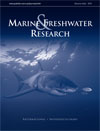Marine and Freshwater Research
Volume 64
Number 6 2013
This paper considered the impact of urban stormwater recharge, a potential source of contaminants, on a groundwater-fed lake used for water supply. Elemental concentrations within lake sediment, collected in the water column and from the lake floor, did not reveal negative impacts of long-term stormwater recharge. Natural processes in the lake, including calcite precipitation, were important in regulating water quality.
Deep-sea crabs exhibit spatio-temporal variability in abundance and population structure, therefore data collected from a single gear type may not represent the whole population. Complementary data from trawl and trap fisheries were analysed for Chaceon macphersoni from eastern South Africa. These confirmed broad gradients in abundance and population structure, but also emphasised subtle trends not apparent from a single gear.
To what extent do we know about the distribution of ‘wide-ranging’ sharks and their overlap with fisheries? This study investigated the distribution of the porbeagle (Lamna nasus) in the southern hemisphere and estimated the trend in relative abundance. Our results highlight the importance of knowledge about distribution for reliable stock assessment and effective management of this species.
Existing research on white sharks (Carcharodon carcharias) in South Africa has focussed primarily on adults (>3.5 m) at island-based pinniped colonies. This study provides information on the existence of a possible inshore nursery area for white sharks in Algoa Bay, South Africa. Defining key habitats for young-of-the-year and juveniles is critical for the management and conservation of white sharks worldwide.
This paper is a first original contribution to provide information about the life cycle of the rough skate, Raja radula, in the Mediterranean. We aimed to estimate age, growth and reproductive parameters for this species from the Gulf of Gabes. An annual deposition of growth bands was confirmed; the oldest female and male in the study were 12 and 9 years old respectively; R. radula has a continuous reproductive cycle.
In order to learn the relationship between the non-indigenous Japanese smelt and the collapse of the native perch population, we investigated the diet of Japanese smelt in Lake Ulungur, China. Cladocerans were the most important food; rotifers, copepods, surface food and chironomid larvae, substituted when cladocerans were scarcer. Seasonal predation by Japanese smelt might influence the collapse of the perch population.
Algal farming by territorial damselfishes is considered an important mechanism for structuring benthic communities and herbivore feeding behaviour on coral reefs. Behavioural observations of Pomacentrus wardi on Lizard Island, Great Barrier Reef, revealed bites taken on soft corals, a previously undocumented phenomenon. The use of soft corals as a potential feeding or farming surface is surprising because of the soft corals’ toxic secondary metabolites, and may have consequences for the success of territorial defence against intruding grazers.
This work is a first effort to assess the transport of salt and nutrients in a tropical estuarine system in Brazil. The objective of this study was to characterise the transport of these properties and phytoplankton biomass in an estuarine channel. The total liquid transport in the rainy season was three times higher than that found for the dry season and the stratification and circulation processes indicated a well mixed environment.
Infauna are ecologically important but rarely considered in biodiversity assessments of coral reefs. We surveyed macrofaunal assemblages from 145 grabs along the Carnarvon Shelf and Ningaloo Reef and found that the region supports high species richness, low abundance and many rare species. Results represent baseline information to assess the efficacy of protected areas in soft-sediment habitats adjacent to coral reefs.




